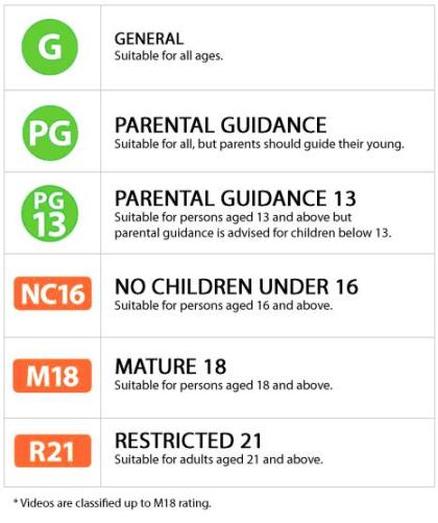Classification of Film in Singapore
Films
All films created in Singapore come under The Films Act. As stated in the MDA website:
Sourced from the Classification Guidelines [CS-7] and The Films Act [CS-5]
The Films Act (CAP. 107) governs the possession, importation, making, distribution and exhibition of films. No person may carry on the business of importing, making, distributing or exhibiting films unless he is in possession of a valid licence.
The Films Act defines "film" as meaning:
· any cinematograph film
· any video recording, including a video recording that is designed for use wholly or principally as a game
· any other material record or thing on which is recorded or stored for immediate or future retrieval any information that, by the use of any computer or electronic device, is capable of being reproduced or displayed as wholly or partly visual moving pictures, and includes any part of a film, and any copy or part of a copy of the whole or any part of a film.
Classification Ratings
The Evolution of Classification
A series of modifications to the classification system took place after 1991, leading to the current multi-faceted, consumer-friendly ratings system.
When R18 was introduced, it led to concerns over an influx of sex-exploitative films within the first month of the classification system’s inception. The rating was modified to R(A) or Restricted Artistic, to signal that only films of artistic merit would be allowed, and the age limit was raised to 21 years.
In 1993, a new rating, NC16 (No Children under 16), was introduced to protect children from viewing films thematically unsuitable for them and to bridge the gap between PG and R21. In March 2004, the film classification system was revised to include an M18 (Mature 18) category to provide more choice for young adults. For the first time, a comprehensive rating system was introduced, from G to R21.
The year also saw Consumer Advice introduced to provide information on the content of the films. This would allow parents and adults to make more informed film-viewing decisions.
Video classification was introduced on 1 July 2004 to mirror the film classification system. The only difference was that the highest rating was M18. As such, videos are currently classified up to M18 while films for theatrical release are classified up to R21.
On 15 July 2011, PG13 which was a recommendation of the Censorship Review Committee 2010 was introduced. This rating serves as an intermediate rating in the PG category which covers a wide range of content catering to both young and old.
The PG13 rating helps to indicate to parents that the content in the film is more suitable for an older teenage audience. This allows for informed choice. It also helps parents in supervising their young children in the selection of films. PG13 is an advisory rating. Parents exercise their discretion as to whether they would want their younger children to watch a PG13 film
With the introduction of PG13, there are now six classification ratings. [CS-6]
When R18 was introduced, it led to concerns over an influx of sex-exploitative films within the first month of the classification system’s inception. The rating was modified to R(A) or Restricted Artistic, to signal that only films of artistic merit would be allowed, and the age limit was raised to 21 years.
In 1993, a new rating, NC16 (No Children under 16), was introduced to protect children from viewing films thematically unsuitable for them and to bridge the gap between PG and R21. In March 2004, the film classification system was revised to include an M18 (Mature 18) category to provide more choice for young adults. For the first time, a comprehensive rating system was introduced, from G to R21.
The year also saw Consumer Advice introduced to provide information on the content of the films. This would allow parents and adults to make more informed film-viewing decisions.
Video classification was introduced on 1 July 2004 to mirror the film classification system. The only difference was that the highest rating was M18. As such, videos are currently classified up to M18 while films for theatrical release are classified up to R21.
On 15 July 2011, PG13 which was a recommendation of the Censorship Review Committee 2010 was introduced. This rating serves as an intermediate rating in the PG category which covers a wide range of content catering to both young and old.
The PG13 rating helps to indicate to parents that the content in the film is more suitable for an older teenage audience. This allows for informed choice. It also helps parents in supervising their young children in the selection of films. PG13 is an advisory rating. Parents exercise their discretion as to whether they would want their younger children to watch a PG13 film
With the introduction of PG13, there are now six classification ratings. [CS-6]

